An open letter to my fellow “southern” Canadians
Robert Olson, BA, MLIS, Librarian & Writer
Written in honour of National Indigenous Peoples Day.
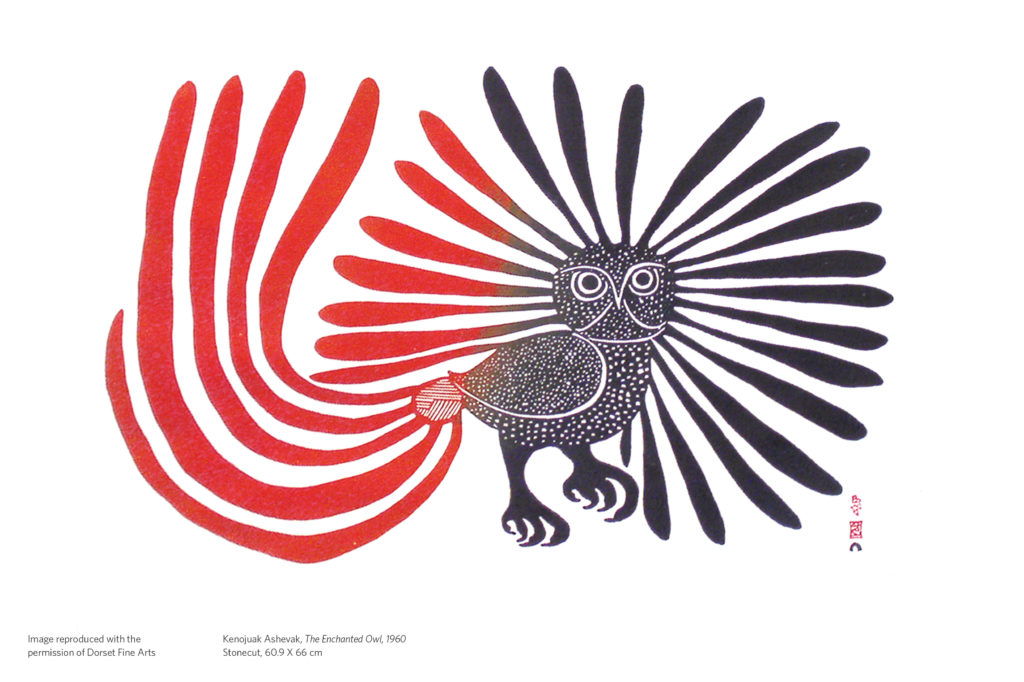
I had the privilege of visiting Canada’s north last fall. It was a tremendously moving experience, one that has motivated me to write about it for the benefit of others. As we approach Canada’s 150th year, more and more attention is being paid to the diversity and beauty that is Canada. This could not be truer of the north: diverse, rugged, majestic. Most of us have never been to the Arctic and yet it is often the climate by which we are characterized… cold, snowy, remote hinterland. As Canadians, we pride ourselves on being compassionate and curious about the world, taking a genuine interest in what goes on outside our borders. We reach out to victims of famine and take in refugees from war-ravaged nations as a matter of course. Yet when it comes to the plight of many of the Indigenous peoples in Canada, and Inuit in particular, most Canadians know precious little.
First Nations, Métis and Inuit are the three distinct Indigenous people groups in Canada with Inuit, being the smallest population of the three. The Inuit population, at approximately 60,000, is relatively tiny, however, their lands make up 35% of Canada’s total land mass and 50% of Canada’s total coastline. This comes as a surprise to many ‘southern Canadians’, who reduce the Inuit’s existence to a logo on a product, the name of a sports team, or other cartoonish variants.
As proof of ignorance, results of Canada’s North Poll, conducted by Ipsos Reid in 2009 (commissioned by Inuit Tapiriit Kanatami, (ITK)), revealed a staggering one-third of our citizens failed a simple true or false test about Canada’s Arctic and Inuit. The second third barely passed, while only the remaining third, an embarrassingly low proportion, was seemingly informed. Test your own knowledge with the trust or false questions at the end of this article.
Yet this Arctic people group is integral to our land and way of life today. Through no choice of their own they have helped shape our sovereignty and northern foreign policy and are paying dearly for it. More Canadians need to hear and understand their story. We need to understand what the last 150 years has looked like for them, in hopes of living out a more constructive next 150 years.
Here are some quick facts:
Inuit live in Canada, Greenland, Alaska and Siberia. In Canada, three-quarters of the Inuit population lives in 53 remote Arctic communities. This area is known collectively as Inuit Nunangat and includes Inuvialut in the Northwest Territories, Nunavik in Northern Quebec, Nunatsiavut on the north coast of Labrador, and the territory of Nunavut.
Inuit comprise 4.2% of the Indigenous population in Canada and 0.2% of the total Canadian population.
Almost half of all Inuit – approximately 27,000 – live in Nunavut, which is about one-fifth the surface area of Canada and Baffin Island, home of Nunavut’s capital city, Iqaluit, is the fifth largest island in the world. This boundless immensity of space, coupled with the relative absence of inhabitants, is truly mind-boggling for many urban dwellers.
Inuit have lived in the central and eastern Arctic areas for at least the last thousand years. Scholars estimate that they migrated from the western Arctic around 1000-1200 AD. Their ability to adapt and persevere under some of the harshest environmental conditions on earth is a true testament to the human spirit. Inuit are a formidable people.
Before contact with Europeans, Inuit lived semi-nomadically, following caribou herds, also hunting muskoxen, walrus and seals. They are the original whalers, capturing especially bowhead whales, the architects of kayaks, and the first people group to establish a low-carb diet. Their beliefs centred around respect for all living things; their collective culture fostered roles for each member of their community as they developed technology and ways of living to thrive in the tundra.
Life in the Arctic
Like many other Indigenous people in Canada, the current living conditions of Inuit often resemble those found in developing countries. Malnutrition is rampant, and many are forced to live in poverty because the cost of food and other necessities is often much higher in the north than in the rest of our country.
There is also an acute housing crisis in this area of the world where shelter is an absolute necessity. There is a phenomenon known as “hidden homelessness” in Nunavut. The “hidden homeless” are people who have shelter but do not have homes of their own. Instances of overcrowding are ten times higher than in other parts of Canada; it is not uncommon to have three families of five living in a three-bedroom house. These would be gainfully employed professionals, forced to live together because of the housing crisis. Housing is not the only issue Inuit face, but all the issues they face relate directly to housing. “No fixed address” in the Arctic is not survivable.
Exacerbating the physical living conditions are the social issues. Domestic violence is prevalent, as is alcohol and solvent abuse, as well as physical and sexual child abuse. The results of The Inuit Health Survey for 2007-2008 indicated that 41% of respondents, 52% female and 22% male, had experienced severe sexual abuse during childhood.

And it doesn’t end there. The living conditions faced by Inuit often lead to a premature and tragic loss of life. In the 1970s the annual suicide rate began to increase. Between 1980 – 1990 it rose from an already high 40 per 100,000 to almost 90 per 100,000. The rate continued to rise for the next two decades, peaking at 120 per 100,000 in 2004, and these rates remain high. By contrast, the rate amongst the entire population of Canada in the same period is between 10-12 per 100,000.
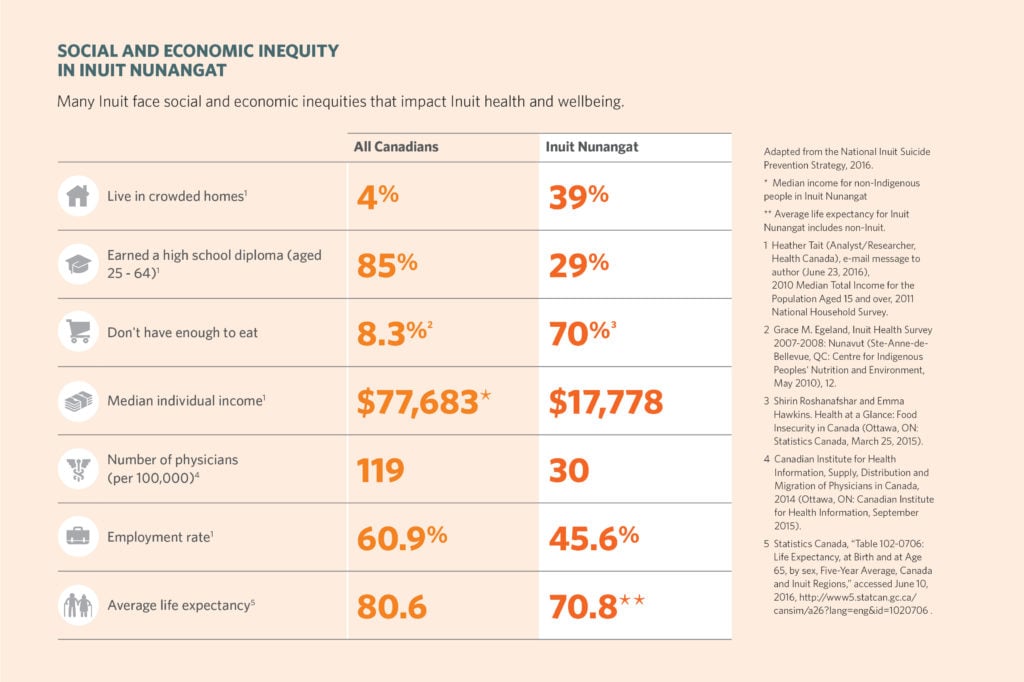
Inuit did not see high rates of suicide until a few decades ago: this is a recent phenomenon and yet now they are dying by suicide at some of the highest rates in the world. What is causing this epidemic? What happened? What went wrong? What led this hearty, semi-nomadic people group, that has survived and thrived in the north for millennia to this point?
The answer is not just what but who: all of us! The root cause of this tragic loss of life is the domination of the general Canadian population and western culture, and the direct and indirect eradication of Inuit culture.
Inuit avoided the harshest effects of colonialism longer than most Indigenous people in Canada because they were shielded by distance and remoteness. However, by the mid-20th century, the vested military, political, and economic interests of the Canadian government obliged them to pay closer attention to Inuit. These new realizations ushered in a later, but no less brutal, colonial era.
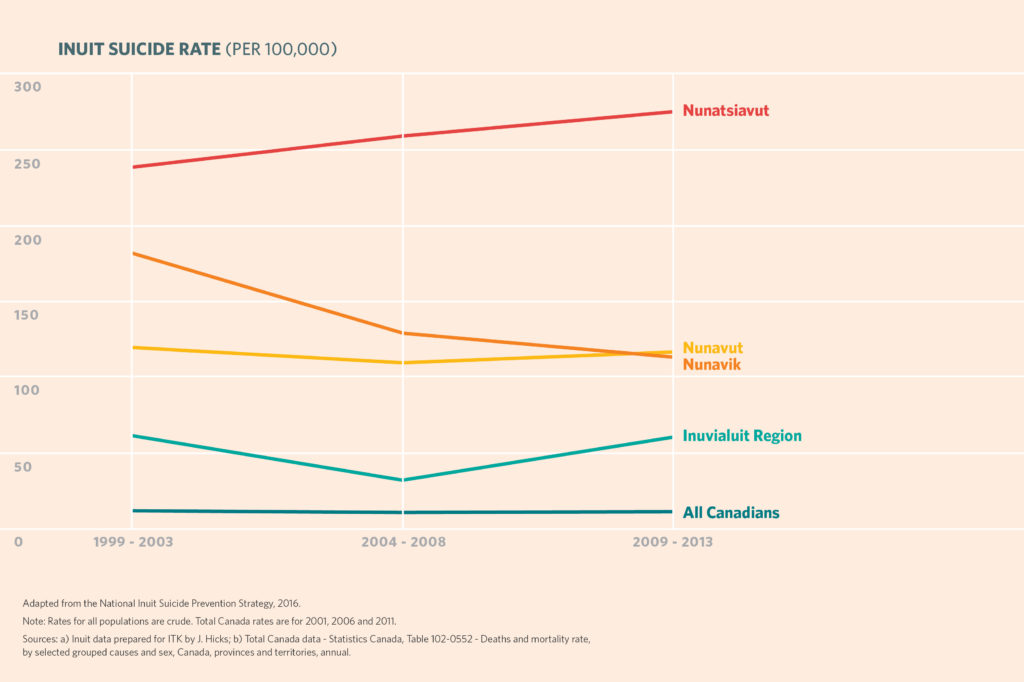
Both the effects of colonization and the Canadian federal government’s Indigenous policies created historical and inter-generational trauma that passed from one generation of Inuit to the next. This trauma has not subsided, and has continued largely because of adverse social conditions like inadequate housing, poverty, substance abuse, physical and sexual abuse, and domestic violence. These elements have created environments of despair where suicide is all too frequently viewed as a real and viable way out.
What were the colonial effects?
Forced Settlement
The first cultural shock to this semi-nomadic people was in the 1950s when the government forced Inuit to settle in communities. At the same time, mainstream Canadian social, political, and economic standards were imposed.
Forced settlement led to the first outbreaks of tuberculosis (TB) Inuit had ever seen, and infected individuals had to leave their communities for treatment in southern Canada. By the mid-1960s, almost half of Inuit had spent time in TB sanatoriums, many suffering devastating mental health effects because of these lengthy separations and many never returning home. Further, families were not apprised of the whereabouts of their missing loved ones, they were not alerted of deaths or where their relative was buried. Many continue to be unaccounted for today.
Settlement life also brought many Inuit into regular contact with alcohol for the first time. Drinking became a coping mechanism for some that helped them deal with this dislocation and disruption. Unfortunately, it often developed into full-blown alcoholism.
Sled-dog killing
Also in the 1950s, under the guise of “disease containment,” the Royal Canadian Mounted Police (RCMP) slaughtered hundreds of Inuit sled-dogs, or qimmiit. Tragically, this critical element of Inuit culture, their primary mode of transportation and hunting, was nearly eradicated. The importance of the sled-dog to Inuit hunting culture cannot be overstated: the Inuktitut word qimutsit captures the relationship between hunter and dog team as one unit: there is no distinction between the two. The loss of sled-dogs was a devastating blow to Inuit self-determination and autonomy. Further, because most hunters were not able to afford or obtain snowmobiles, they could no longer hunt. Many were forced into idleness and consequently became even more dependent on the government.
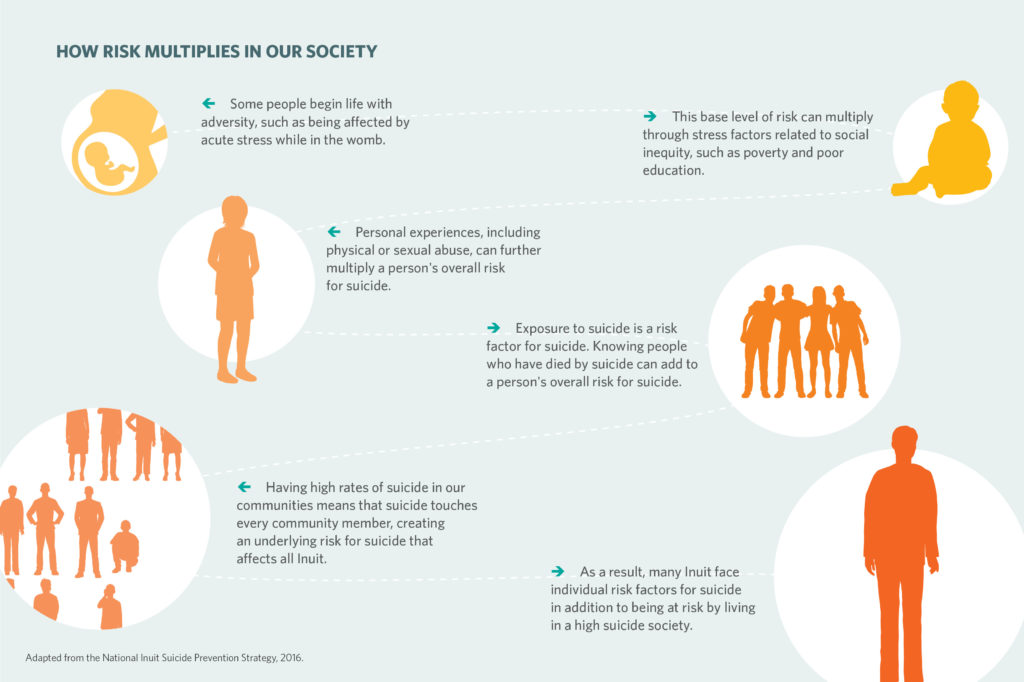
Residential Schools
The experience of residential schools has had a tremendous and lasting negative impact on Inuit, as it has on many First Nations and Métis communities. The Inuit residential school era began in the 1950s, much later than in southern Canada. By 1964 more than 75% of Inuit children were attending residential schools. It was in this setting that the systematic assimilation of Inuit children – and corresponding eradication of Inuit culture – could be conducted in earnest.
It was a deliberate federal policy to assimilate the young Inuit into full Canadian citizenship. This meant the suppression of all things Inuit. The curriculum taught in schools was identical to that taught in the south, and students were forbidden to speak Inuktitut. Children were taught that local food, referred to as “country food,” was inferior. They were estranged from the unique, cultural teachings of their Elders, and consequently lost valuable cultural skills and knowledge. An ever-widening gulf separated Inuit parents from their children, creating an increased inability to communicate with one another. Most disturbingly, Inuit children were abused physically and sexually in these residential schools. The significant, lasting impact of these crimes is immeasurable.
Relocations
Egregious acts did not end there; forced relocation was yet another blow. In the 1950s, the Canadian government forcibly relocated some Inuit families from northern Quebec to the high Arctic, 1500 kilometres north from their home. These new settlements, Grise Ford and Resolute, are in the middle of an Arctic desert. The terrain is rugged and there are very few animals to hunt; the plentiful caribou of northern Quebec are nowhere to be found. This group of people, for generations hunters of land animals, were now forced to learn how to hunt walrus and whale overnight in order to survive. Further, the average temperature of this new locale is 20C colder than in their former home.
The official government statement regarding relocation was that it was intended to preserve traditional Inuit ways of life, but the real motive was political. At this same time, the Cold War was escalating, and there was a growing American military presence in the north: the government relocated people there as a show of might. And who better to live in this uninhabited land than Inuit who have lived in the tundra for thousands of years? Southerners did not make a distinction between the various sub-regions of the north: sub-Arctic, Arctic, North Pole… it was all NORTH, so what’s the difference? The Inuit were relocated, used as props and pawns by the Canadian government, stripped entirely of their way of life. The cost was immense: people of these high-north communities were now completely dependent on the government for survival. Self-determination had all but been obliterated.
During these forced sociological changes, the suicide rates among Inuit began increasing, and continued to climb in the 1960s and 70s.
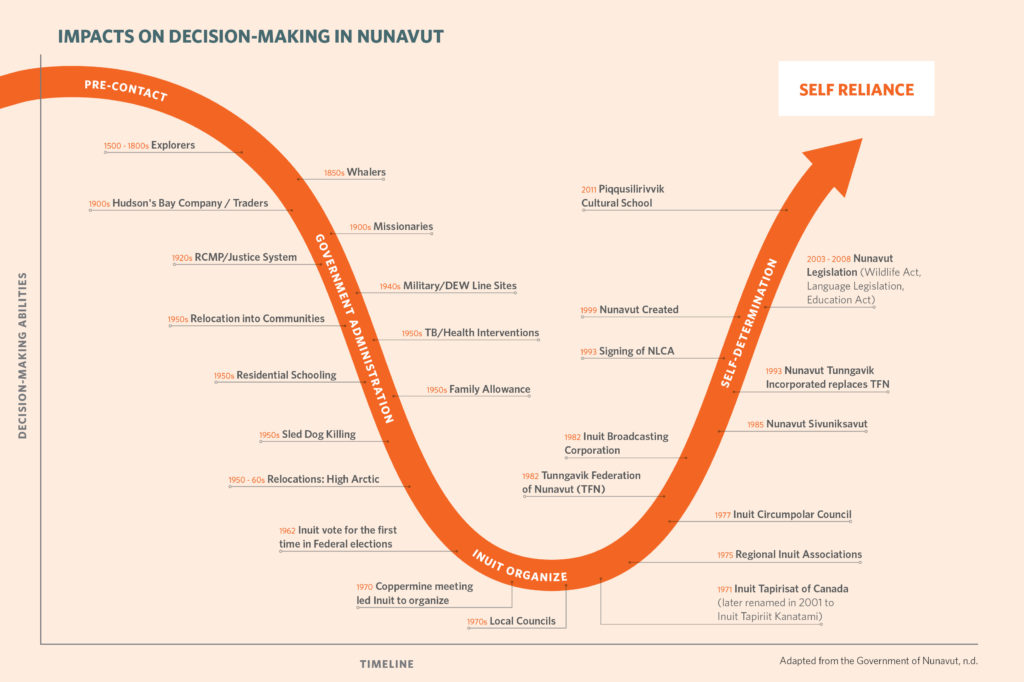
Where to from here? A return to self-reliance and self-determination
Faced with a heavy history and almost equally bleak present, is there hope that Inuit can return to a state of self-reliance on their own terms? Absolutely!
Inuit have an integrated and unified system of traditional knowledge and ways of life called Inuit Qaujimajatuqangit (IQ). It is a world view that helps ensure cultural continuity, stability, and well- being, and includes practical knowledge as well, “not only the action of doing things, but also knowing why they are done as they are.”
The core principles of IQ include: providing for family and community, decision making through consensus, working together for a common cause, and respect for land, animals and the environment (among others).
Unfortunately, IQ has been somewhat eroded after decades of colonialist exposure, most visibly in the continued crisis-levels of suicide. Paradoxically, these awful consequences have acted as a strong catalyst to reinvigorate the principles of IQ. Thus, Inuit have begun to rely on this world view to move forward in positive ways.
Inuit are, after all, extremely resilient. How could they be otherwise, after living in such challenging natural and social settings for so long? Resiliency is at the heart of IQ. Recent concerted plans to strengthen this way of life have been reflected in the forward-thinking social, political, and economic strategies adopted in both Nunavut and other parts of Inuit Nunangat. It could be said that IQ is the foundation on which collective Inuit protective factors are based, and that through it a restoration of Inuit good health and well being can be achieved.
The Government of Nunavut (GN) formally adopted the approach and worldview of IQ when the territory of Nunavut was formed in 1999. This new government used IQ practices to guide decisions, create policies, and set government values that would truly represent the people it served. To this day, they have an inter-departmental group made up of non-governmental members called the Inuit Qaujimajatuqangit Katimajiit whose role is to help implement IQ teachings into Nunavut’s government and public agencies.
Nunavut’s departments of education, justice, and culture are directly informed by IQ perspectives. A most significant GN mandate has been the implementation of IQ in all Nunavut schools.
The area of suicide prevention is being approached with a cooperative, single-minded vision by the GN: they are determined to see these rates decline. In 2004, the GN made a pledge to prepare a “suicide prevention strategy with a focus on wellness”. The Embrace Life Council (IIKELC) was formed the same year, and this non-profit suicide prevention organization brought together the RCMP and other stakeholders to address suicide prevention.
In 2008, the GN, Nunavut Tunngavik Incorporated (NTI), the RCMP V-Division, and the IIKELC partnered to create an official suicide prevention strategy for the territory. In 2010, the Nunavut Suicide Prevention Strategy (NSPS) was released. This is true leadership. Most provinces and Canada itself do not have suicide prevention strategies: Nunavut is leading the way. An action plan (2011-2014) was subsequently created to ensure that the goals outlined in the strategy were met.
Suicide prevention is a long-game: this kind of sociological change takes time and thus, suicide in Nunavut has yet to be contained. The territory saw a spike in suicides in 2014 which prompted a coroner’s inquiry into the epidemic, yielding 41 recommendations for action. Two of these recommendations included declaring suicide a public health crisis, and creating a minister responsible for suicide prevention. These measures were adopted, and an action plan to implement the other called Resiliency Within: An Action Plan for Suicide Prevention in Nunavut, 2016-2017 was released in 2016.
These ongoing efforts in Nunavut clearly show that the suicide problem is not easily solved, and that it requires long-term, sustained efforts.
The role of youth
Young Indigenous people are the fastest growing demographic in our country. Unfortunately, they are also the most at-risk group for suicide (By comparison, middle-aged men are the most at-risk group in the general population.) Inuit also have the youngest population of all Indigenous people, with a median age of 23 years, compared with the rest of Canada’s 41 years.
In 2016, ITK, the national representational organization for Inuit in Canada, released the National Inuit Suicide Prevention Strategy (NISPS). ITK feel Inuit need a strategy that focuses on the circumstances unique to Inuit: their history, and their social and economic experiences. The release of this strategy helped identify suicide prevention as the top priority, and Inuit youth themselves are identified as primary stakeholders in the fight against the epidemic. Any hope for resilience and recovery among all Inuit people rests with the youth.
The NISPS publication targets six specific areas including promotion of Inuit culture:
- nurturance of Inuit children from birth,
- access to mental health services,
- treatment of unresolved grief and trauma,
- creation of cultural continuity, and
- utilization of IQ for resilience training and suicide prevention.
Support in each of these areas can contribute to an Inuit child’s development, and key interventions can be undertaken at critical moments in their lives. This targeted support can help ensure a healthy upbringing into adulthood. As a follow-up strategy, ITK will assess if they are achieving the objectives identified in the NISPS every two years.
These are tremendous initiatives! Inuit should be applauded – after years of being silenced and oppressed by the government, they called upon their own resiliency and autonomy and took suicide prevention into their own hands – and have done so in significant and meaningful ways.
How can we help? What is our role?
We need not only praise Inuit’s efforts at addressing the suicide crisis but also take inspiration from it! Suicide is a public health crisis in Canada; we need to address it in the same focused and meaningful way that Inuit have demonstrated.
Besides recognition, Inuit need support from the rest of Canada; they cannot do it alone. That is why Health Canada’s investment of $9 million over a three-year period to provide support for front-line services, early childhood development programs, and Inuit-led suicide prevention programs is fundamental.
For these programs to be successful in the long-term, however, financial investments need to be sustained. Will Ottawa maintain its fiscal support in the years to come? Suicide prevention at a population level is not achieved quickly; we must be in it for the long haul. The financial commitment, while practical and necessary, is also a step toward reconciliation. Arguably, suicide prevention in Indigenous communities, Inuit included, must be predicated on reconciliation and the healing that comes from forgiveness. The first step of reconciliation is recognizing the wrongs that have been done. Are we ready to take this stand?
This is the role that we Canadians who live in the southern part of this country must play. We need to educate ourselves about Inuit. We need to know more about their history, their current living conditions and the role we played in bringing them to this present state. Knowledge breeds empathy, and as we learn more about Inuit, our fellow Canadians, we can gain valuable insight into their history, their unique culture, the social and economic inequities and the responsibility we have to raise the standard of living of all Canadians.
The Truth and Reconciliation Commission (TRC), which addressed the effects of residential schools on the Indigenous peoples in Canada, recommends mandatory school curricula for all students in the country about “History and contributions of Indigenous people in Canada”. I agree wholeheartedly. Only when we understand the past can we deal with the future. Inuit history is part of our history – the destiny of the Inuit is part of Canada’s destiny. As we embark on the next 150 years, we have the opportunity to broker hope … and grow constructively together as Canadians. We are truly all in this…together!
North Poll Questions
True or false?
- It is possible to drive to all Inuit communities from southern Canada.
- All Inuit communities have at least one doctor.
- Approximately 1 in 4 Inuit teenagers finish high school.
- The concentration of artists in Nunavut is 4 times higher than the national average.
- The average life expectancy for Inuit is 15 years lower than for other people in Canada.
- The cost of living is 50% higher for the average Inuit than for non-Indigenous Canadians.
- Inuit live primarily on reserves.
- The capital of Nunavut is Tuktoyaktuk.
- The Inuit are considered First Nations.
- Inuit pay all taxes including GST, income tax, and PST (where applicable).
Answer key:
- F, 2. F, 3. T, 4. T, 5. T, 6. T, 7. F, 8. F, 9. F, 10. T
A great article, thank you. A real eye-opener.
An excellent article – well done. Should be forwarded to Canadian School Boards through out the country as a kick start to encouraging more much needed curriculum development.